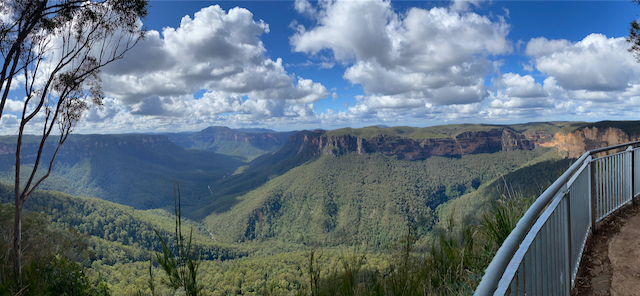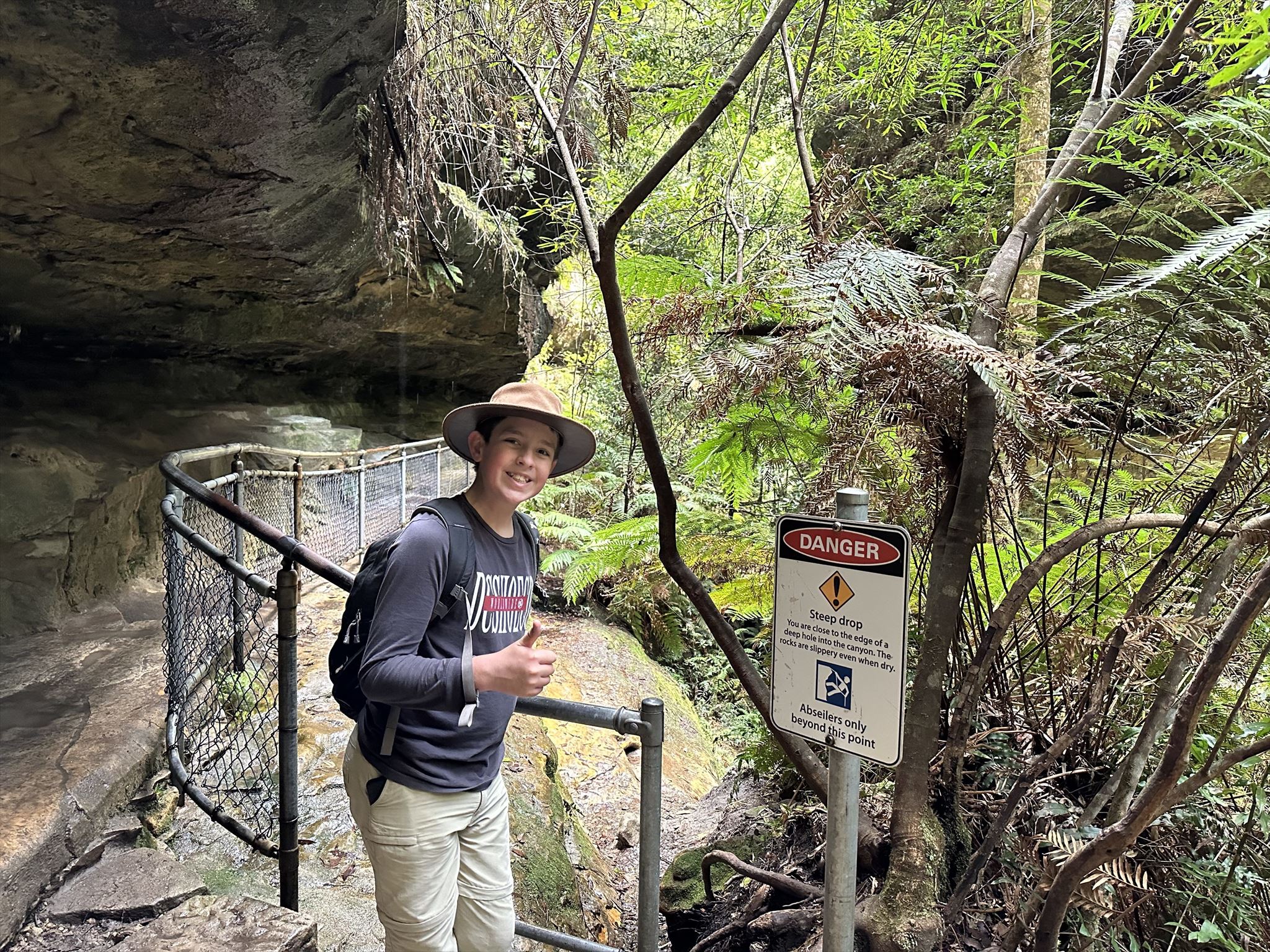The Grand Canyon, Blue Mountains Blackheath
The Grand Canyon walking track is a beautiful ~6.5km loop track taking you through some of the best scenery in the Blue Mountains, It's located near Blackheath, and accessible from Evans Lookout Road, or various ways coming from the Grose Valley. The hike features a wide range of diverse ecosystems, throughout the walk you will experience vast eucalypt forests, fern-filled gullies, towering sandstone cliffs and views of the expansive Grose Valley...
This EarthCache will lead you through the Grand Canyon to learn about the geology of this canyon while. NSWNPS website suggests taking 3-4 hours to complete the 6.5km loop - we did it fairly leisurely, stopping a lot, in around 2.5 hours. Parts of the walk are very slippery, steep and wet, so make sure you wear supportive footwear. You will ascend and descend over 350 metres during the walk.
Do not attempt this EarthCache after periods of heavy rain, this canyon is known to have varying water levels and can become dangerous rapidly. If in doubt check with NSWNPS. Please make sure you read the logging requirements at the bottom of the page.

Link to NSWNPS Map -> https://www.nationalparks.nsw.gov.au/-/media/npws/maps/pdfs/tdd/grand-canyon-track/grand-canyon-track-map.pdf
Geology
The Blue Mountains are home to the highest density of slot canyons anywhere in Australia, with over 900 distinct canyons spread across the region, each varying in depth, width and length. This canyon traverses through the Blue Mountains National Park between Medlow Bath and Blackheath. It is one of the largest canyons in the Blue Mountains and one of the most popular places for experienced hikers and canyoners to come and explore, with a wide variation of landscapes, lots of wildlife, amazing views and for those with specialised gear, abseiling and canyoning.
This is a prime example of a slot canyon, which has been formed by Greaves Creek over time. Greaves Creek starts at Lake Medlow and winds its way through the dense bushland, carving a deep canyon as it goes. The canyon is approximately 40m deep at its deepest point and approximately 2km long.
In this part of the Blue Mountains, canyons are formed when water runs down planes of weakness in a rock shelf. The specific rock this canyon has formed in is a soft layer of Burra-Moko Sandstone slowly carving through the rock. As the water carves through the rock, it meets certain obstacles like boulders, and the water curves around the boulder revealing small cylindrical indents in the sides of the canyon walls. As the canyon ages, it slowly gets deeper due to the eroding sandstone. As rock gets eroded away, the water picks up small abrasive particles of sand, rock, silica and other deposits, which assist in forming the canyon.
What is a canyon?
A canyon is a deep, narrow valley with steep sides. The word “canyon” comes from the Spanish word cañon, which means “tube” or “pipe.” The term “gorge” is often used to mean “canyon,” but a gorge is almost always steeper and narrower than a canyon.
How are canyons formed?
Canyons are formed through many different geological forms of erosion, typically by water, wind, ice or tectonic forces. Here is a brief overview of each of these forces.
- Water Erosion: One of the primary factors in canyon formation is water. Rivers and streams gradually erode the landscape as they flow downhill, cutting through layers of rock. Over time, the continuous flow of water carves deep channels, widening and deepening the valley, creating the steep-sided walls characteristic of canyons. The erosive power of water is especially pronounced during periods of increased flow, such as heavy rainfall or snowmelt.
- Wind Erosion: In arid regions, wind can also play a role in canyon formation. Wind-blown sand and sediment act as natural abrasives, wearing away at exposed rock surfaces over time. This process, known as aeolian erosion, can shape canyons in desert areas, where wind patterns and sandstorms gradually sculpt the landscape.
- Ice Erosion: In colder regions, glaciers can contribute to canyon formation. Glacial erosion occurs as large bodies of ice slowly move across the land, scraping and gouging the underlying rock. This process, called glacial plucking and abrasion, can create deep, U-shaped valleys, often referred to as glacial canyons.
- Geological Uplift: Geological uplift, which can result from tectonic forces or the gradual movement of Earth's crust, can also contribute to canyon formation. As the land uplifts, rivers and other erosive agents work to cut through the rising terrain, creating deep valleys or gorges. This uplift exposes underlying rock layers, allowing for the erosion and excavation of canyons.
- Differential Weathering: Differential weathering, the process where rocks of different hardness and resistance to erosion weather at different rates, can further shape canyons. In areas with varying rock types or layers, more resistant formations can create cliffs or walls, while softer or less resistant layers erode more quickly, resulting in the formation of a canyon.
Different types of Canyons
As canyons form, different types of rock and geology of different areas will form different types of canyons, The main types being Mountain-Type Canyon, Box Canyons Slot Canyons.
- Mountain-type canyons: These canyons form through the combined processes of uplift and erosion in mountainous regions. Tectonic forces exert pressure on the Earth's crust, causing the land to rise and create elevated terrains. Over time, rivers, streams, and other erosive agents gradually carve their way through the uplifted landscape, sculpting steep-sided valleys and rugged landscapes. The power of water, glaciers, and occasional landslides shapes these canyons, showcasing the enduring forces that have shaped the Earth's surface over millions of years. The towering peaks, jagged cliffs, and expansive vistas of mountain-type canyons offer a captivating glimpse into the remarkable geological history and natural beauty of our planet.
- Box canyons: Distinctive geological formations with a rectangular shape. They result from a combination of geological faulting and gradual erosion and are usually made from harder rocks such as limestone. Movement or displacement of rocks along a fault line creates an elevated or depressed block of rock, forming the foundation of a box canyon. Over time, the surrounding landscape is eroded by water and wind, deepening and shaping the canyon. Box canyons feature steep, vertical walls that enclose the canyon from all sides, creating an atmosphere of seclusion and mystery. The narrow entrance or exit adds to their allure, inviting exploration and adventure in these captivating natural wonders.
- Slot canyons: These geological marvels are formed by water erosion, particularly during intense flash floods. Slot canyons typically occur in areas dominated by soft sedimentary rock, such as sandstone. As water flows through these regions, it carves intricate passageways, winding and twisting through layers of rock. A slot canyon has depth-to-width ratios that typically exceed 10:1 over most of its length and can approach 100:1. Over countless years, the erosive forces of water gradually sculpt and refine these narrow canyons, resulting in breathtaking natural formations. The interplay of light and shadow on their walls, created by sunlight filtering through narrow openings, adds to their allure, revealing nature's artistic touch.
Logging Requirements
To log this cache, you will need to answer some questions and take a photo for your online log. You may log your find immediately - we will reply to all messages and emails. If we do not receive your answers and photo within 10-14 days, your log will need to be deleted.
* When answering these questions, do not attempt to pass any handrails/barriers. GPS reception in the canyon is flaky - the waypoints are in obvious spots. *
Waypoint 1 - Photo 1, Abseilers only beyond this point sign. (V1)
This waypoint is located where people interested in canyoning enter the canyon, you will find a sign which says 'Abseilers only beyond this point' and 3 eye bolts with a chain attached to them.
You are required to attach a photo to your log - it needs to include the sign, with you or your GPS, mascot or geocaching name in the frame. See the photo below for an example.

Waypoint 2 - Question 1, Bridge. (V2)
This waypoint is located at a small wooden bridge that goes over a sub-branch of the main Grand Canyon. From the bridge, you are required to answer the following question.
1. Identify which type of canyon the Grand Canyon is and give a suitable explanation for your decision. (box canyon, mountain-type canyon or slot canyon)
Waypoint 3 - Question 2, Base of Canyon (V3)
This waypoint is located at the base of the canyon after you descend into the canyon itself. You need to exit the track a bit and walk down to the water's edge to answer this question.
2. Identify which of the erosive forces listed in the lesson above apply to this environment, and give visible evidence for these forms of erosion in the canyon around you.
[As this cache is located in the Blue Mountains National Park, please abide by all National Park rules, stick to the path and do not cross any barriers or track closures under any circumstances, please add a note to the cache page informing us of any track closures or issues with this cache. For more information on this particular area, visit this site - https://www.nationalparks.nsw.gov.au/things-to-do/walking-tracks/grand-canyon-track ]